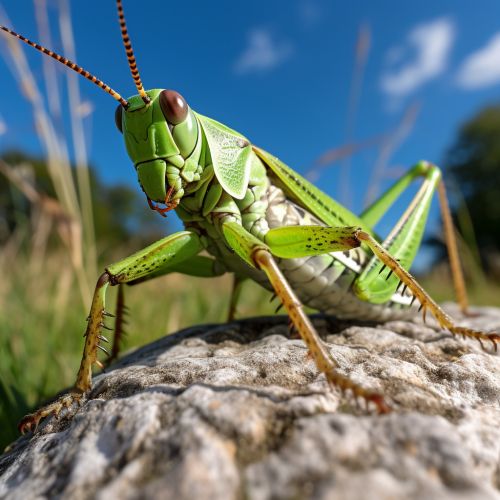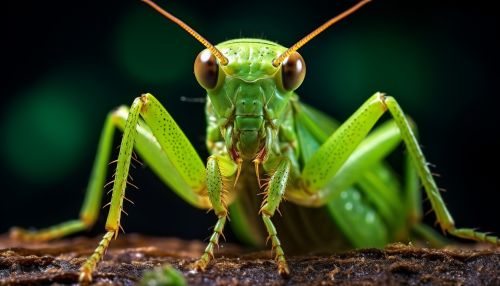Orthoptera
Introduction
Orthoptera is an order of insects that includes the familiar grasshoppers, crickets, katydids, and locusts. These insects are characterized by their large hind legs, which are adapted for jumping, and their stridulatory (sound-producing) organs. The Orthoptera order is diverse, comprising over 20,000 species distributed worldwide.


Morphology
Orthopterans are typically medium to large insects. They possess a chitinous exoskeleton, which is divided into three main parts: the head, thorax, and abdomen. The head houses the insect's sensory organs, including compound eyes, antennae, and mouthparts. The thorax, divided into three segments, is where the insect's six legs and two pairs of wings (if present) are attached. The abdomen, the largest part of the body, contains the digestive, respiratory, and reproductive systems.
Head
The head of an orthopteran is typically large and mobile, with a pair of large compound eyes that provide a wide field of vision. The antennae, which can be short or long depending on the species, are sensory organs used for detecting smells and vibrations. The mouthparts are of the biting type, allowing these insects to consume a variety of plant materials.
Thorax
The thorax of an orthopteran is divided into three segments: the prothorax, mesothorax, and metathorax. The prothorax bears the first pair of legs and is often enlarged in grasshoppers and locusts. The mesothorax and metathorax each bear a pair of legs and a pair of wings. The hind legs are particularly large and powerful, adapted for jumping. The wings, when present, are typically clear and membranous, although in some species they may be reduced or absent.
Abdomen
The abdomen of an orthopteran contains the insect's digestive, respiratory, and reproductive systems. It is divided into several segments, each of which may bear a pair of small, flap-like structures called cerci. In some species, the males have a pair of claspers at the end of the abdomen, used for holding the female during mating.
Behavior and Ecology
Orthopterans are primarily herbivorous, feeding on a wide variety of plant material. Some species, however, are omnivorous or even carnivorous, feeding on other insects, small invertebrates, and even small vertebrates. Orthopterans are known for their ability to jump, which they use to escape predators and move around their environment.
Communication
Orthopterans are well known for their acoustic communication. Males of many species produce sounds, known as stridulations, by rubbing their wings or legs together. These sounds are used to attract females for mating and to ward off rival males. Some species also produce sounds as a form of defensive behavior when threatened.
Reproduction
Orthopterans have a variety of reproductive strategies. Most species are oviparous, laying eggs that are often deposited in the ground or in plant tissue. Some species are ovoviviparous, with the eggs hatching inside the female's body. After hatching, the young, known as nymphs, undergo a series of molts as they grow and develop into adults.
Classification
Orthoptera is divided into two main suborders: Caelifera, which includes grasshoppers and locusts, and Ensifera, which includes crickets and katydids. These suborders are distinguished by several morphological and behavioral characteristics, including the structure of the antennae, the location of the stridulatory organs, and the mode of sound production.
Caelifera
Caelifera, the grasshoppers and locusts, are characterized by their short, stout antennae and their stridulatory organs located on the abdomen. They are typically diurnal, active during the day, and their stridulations are usually produced by rubbing the hind legs against the wings.
Ensifera
Ensifera, the crickets and katydids, have long, thread-like antennae and their stridulatory organs are located on the wings. They are typically nocturnal, active at night, and their stridulations are usually produced by rubbing the wings together.
Economic Importance
Orthopterans have both positive and negative impacts on human economies. On the positive side, they are an important part of many ecosystems, serving as a food source for many animals and helping to control plant populations. On the negative side, some species, particularly locusts, can become serious agricultural pests, causing significant damage to crops.
Conservation
Many species of Orthoptera are of conservation concern due to habitat loss, pesticide use, and climate change. Conservation efforts for these insects often involve habitat protection and restoration, as well as research into their ecology and behavior.
